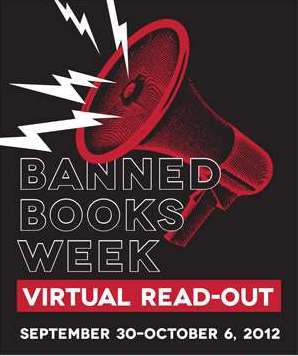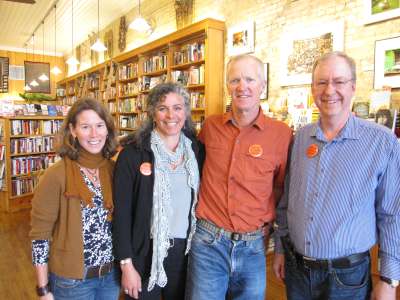Banned Books Week 2.0
By Chris Finan, President of the American Booksellers Foundation for Free Expression
Banned Books Week turned 30 this year, but this was not your grandmother’s celebration of the freedom to read.
Since its founding, the centerpiece of Banned Books Week has been the display of banned and challenged titles on tables in bookstores and libraries around country. This year the celebration began on the Internet with a tremendously creative two-minute video produced by Bookmans, an independent bookstore with six locations in Arizona.
The Bookmans video was a contribution to a read-out of banned books that was launched on the Internet last year. Most of the more than 1,000 videos that have been posted on YouTube feature people reading passages from their favorite books. The Bookmans video shows a series of customers and staff members reading a single line from different censored books. Each line was carefully chosen to celebrate the importance of books, reading, and free speech.

The moving message of the video, combined with skillful editing by Harrison Kressler, Bookmans’ video producer, helped it become the hit of Banned Books Week. More than 17,000 people watched it on YouTube, making it our most popular video to date.
City Lights Bookstore in San Francisco also joined the read-out, producing a series of wonderful readings by writers and leading members of the literary community, including Lawrence Ferlinghetti, the store’s founder. Director John Waters read from Lady Chatterley’s Lover.
Other bookstores who contributed to the read-out include Chapter One Book Store, UConn Co-op, Vintage Books, Poor Richard’s Bookshoppe, The King’s English Bookshop, The Book House, and Bookmamas. The videos may be viewed here. (Some are exhibited on playlists.)
But the Internet read-out is only one of many new things about Banned Books Week. The sponsors of Banned Books Week — the American Booksellers Foundation for Free Expression, the American Library Association, the Association of American Publishers, the National Association of College Stores, and the American Society of Journalists and Authors — have created a steering committee to plan for the event throughout the year. The Internet read-out was one of our first ideas.
The committee has also invited new groups to become sponsors, including the National Coalition Against Censorship, the National Council of Teachers of English, the Comic Book Legal Defense Fund, and Project Censored.
As a result of these organizational changes, Banned Books Week has grown. Press coverage of the event doubled last year. We don’t have statistics for this year yet, but it appears that coverage continues to increase. In the past, we have had trouble placing opinion pieces in newspapers during Banned Books Week, but this year the Louisville Courier-Journal approached us for a column. KPFA, a radio station in San Francisco, devoted a full hour to Banned Books Week.
This doesn’t mean that displays of banned books are old hat. They remain the most effective means of delivering our message that even in America censorship is a problem. The “ah-ha!” moment occurs when bookstore customers and library patrons see that some of their most beloved books have been challenged.
 |
|
Libby Cowles, Andrea Avantaggio, and Peter Schertz with ABFFE President Chris Finan during Maria's Banned Book Week celebrations. |
Banned Books Week continues to give booksellers a great opportunity to bring customers into their stores. I saw this for myself this year when I spent Banned Books Week in Durango, Colorado, at the invitation of Maria’s Bookshop.
Peter Schertz and Andrea Avantaggio, the owners of Maria’s, have been expanding their celebration of Banned Books Week for several years. It happened that this year Banned Books Week coincided with the Durango Literary Festival, and festival organizers were planning a program on censorship. Peter invited me to join the panel, which included Ellen Hopkins, whose books are frequently challenged. It seemed like a long way to go for one appearance, so I asked him to see if anyone else might want to hear about banned books.
I was surprised when Libby Cowles, Maria’s community relations manager, lined up three classroom talks at Ft. Lewis College, a radio interview, and a breakfast speech to the town’s booksellers and librarians. From the first day in Durango, my visit got great coverage in the local newspaper, which published a column I wroteon the front page of the Sunday opinion section. The publisher even invited me to address his editors at their daily meeting.
While I want to believe that the warm reception in Durango was a response to my rugged good looks, it was largely the result of Libby’s efforts and Maria’s excellent relations with community leaders.
There was something else at work as well. The message of Banned Books Week is that we only possess free speech as long as we are willing to fight for it. When people are made aware of censorship, they are grateful to the booksellers, librarians, teachers, parents, and kids who are fighting back.
There is no danger that Banned Books Week will grow old anytime soon. Our challenge is to continue to find new ways to carry the message.
For more information about ABFFE and its mission is to promote and protect the free exchange of ideas, visit abffe.org or e-mail Chris Finan.
